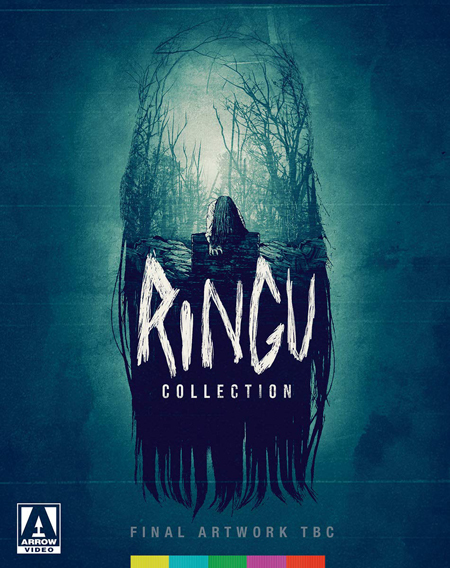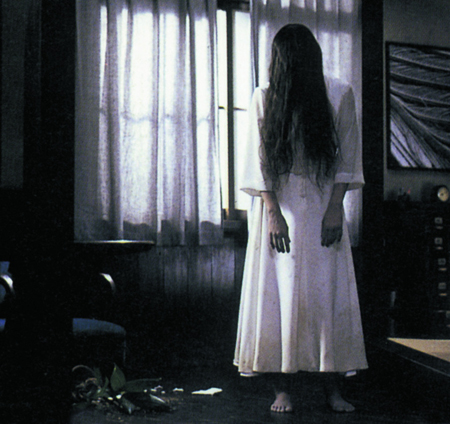
“BE
KIND, REWINDâ€
By
Raymond Benson
On
second thought, don’t rewind this tape. Destroy it! Don’t let anyone in your
family watch it!
The
phenomenon known as “J-Horror,†or Japanese Horror, had been brewing for
decades (Kwaidan, anyone?), but it was Hideo Nakata’s Ringu (“Ringâ€)
in 1998 that jumpstarted the movement. Motion pictures of the ilk are usually
derived from ghost stories, Japanese folklore, and revenge tales, mixed with a
modern horror-film sensibility, a dash of gruesomeness, and often a creepy
dripping-wet ghost-girl (a yūrei) with long
black hair covering her face coming to get you in your dreams or out of, say, a
television set, in your waking hours.
Ringu
spawned
a franchise in and of itself, with eight films in total, two television series,
six manga adaptations, five international film remakes, and two video games.
It’s
only fair to acknowledge author Koji Suzuki’s 1991 novel and its subsequent
sequels to form the initial trilogy, and then three later books in the
universe. There was also an earlier made for television feature, Ring:
Kanzenban, in 1995 that did little to advance the property. Only after the
massive success of the first theatrically released feature did the thing take
off. The original Ringu and its first sequel, Rasen, mostly follow
the books, whereas the rest of the movies went in another direction.
Most
people in the West probably know the franchise from Gore Verbinski’s Hollywood
remake, The Ring, starring Naomi Watts (2002, and it’s a good one).
Nevertheless, the Japanese originals are worth investigating, especially for
viewers who are horror film buffs. Arrow Video has released a Blu-ray box set
of the first four pictures in the series to satisfy this audience, and the
product is a delight.
Disk
One: Ringu, directed by Hideo Nakata. It’s the story of a videotape that
kills people who watch it. As soon as someone views the tape, the phone rings. A
voice remarks, “Seven days.†Then, seven days later, the ghost of a young
woman, Sadako Yamamura, who was thrown by her own father into a well to die thirty
years earlier, appears and kills the viewer. There’s a way out, though… but
that won’t be revealed here.
While
the use of a VHS videotape as the object of menace is today dated and quaint,
the ideas behind the story are still potent. This is an unsettling little
movie. It of course didn’t have the kind of budget that the American remake
had, but that could be why the picture is so effective. Nakata’s direction is
pitch-perfect, with no cheap jump-scares or gratuitous gore. Ringu works
by way of the suspense and sense of surreal macabre that it generates.
Arrow
presents the feature in a brand new 4K restoration from the original camera
negative (approved by DP Junichiro Hayashi), and the 1080p high definition looks
marvelous. The soundtrack is a lossless Japanese DTS-HD Master Audio 5.1 and
PCM 2.0, with optional English subtitles. It’s accompanied by a new audio
commentary by film historian David Kalat.
The
supplements are plentiful—“The Ringu Legacy†is a series of interviews from
critics and filmmakers on the Ringu series; “A Vicious Circle†is all
about the career of director Nakata; “Circumnavigating Ringu†is an interesting
video essay by author and critic Alexandra Heller-Nicholas on the evolution of
the series; a stand-alone clip of Sadako’s video; and theatrical trailers. A
reversible sleeve with commissioned artwork and the theatrical poster adorns
the jewel case.
Disk
Two: Ringu 2, directed by Hideo Nakata, and Rasen,
directed by George Iida. The first sequel to Ringu was Rasen (“Spiralâ€),
a true adaptation of Suzuki’s second book in the series. Oddly, it was released
in theaters simultaneously with Ringu in order to push the films into
franchise mode. While Rasen is a fine film, it bombed, while Ringu became
an international hit. Rasen was relegated to forgotten status and was
for some time suppressed as the sequel to Ringu. Its story continues
with the investigation into the history of the videotape and Sadako’s tragic
life, and the picture features some of the same actors from Ringu. It’s
not bad, but it’s true that it doesn’t have the impact of the first movie.
To
rebound, the studio immediately commissioned Nakata and much of the team from Ringu
to quickly make a “proper†sequel, which was called Ringu 2 and
released in 1999. Like Rasen, it begins at the end of Ringu, but
then explores new mythology behind the story. There are characters and actors
held over, but new ones are introduced as well. Ringu 2 is quite good
(better than Rasen, to be sure), but attempting to top Ringu is a
tall order. Nevertheless, the eerie factor is up to 11, and there is some
striking imagery throughout.

Both
sequels are in high definition 1080p presentations with the same audio specs as
Ringu (without audio commentaries). Supplements—“The Psychology of
Fear,†a lengthy interview with author Suzuki; theatrical trailers; and another
reversible sleeve on the case.
Disk
Three: Ringu 0: Birthday, directed by Norio Tsuruta. Released in 2000, this
is, as the name implies, a prequel to Ringu, with events taking place
while Sadako was alive; hence, she is the protagonist of this story and the
audience gets to witness her tragic fate. Like Ringu 2, the picture is
effective, moody, and perhaps a more engaging film than its predecessor simply
because of the lore it established.
Again,
the movie is in high definition 1080p with the same audio specs. This one
contains an audio commentary by Alexandra Heller-Nicholas. Supplements—“Spooks,
Sighs and Videotape,†an excellent video essay by Jasper Sharp on the
entire J-horror phenomenon; archival behind-the-scenes footage; deleted scenes;
theatrical trailers; and another reversible sleeve.
The
entire set comes in a box with a nicely illustrated booklet containing several
essays. In short, it’s another classy package from Arrow, which is proving
itself to be a superb producer of Blu-ray classics.
CLICK HERE TO ORDER FROM AMAZON
